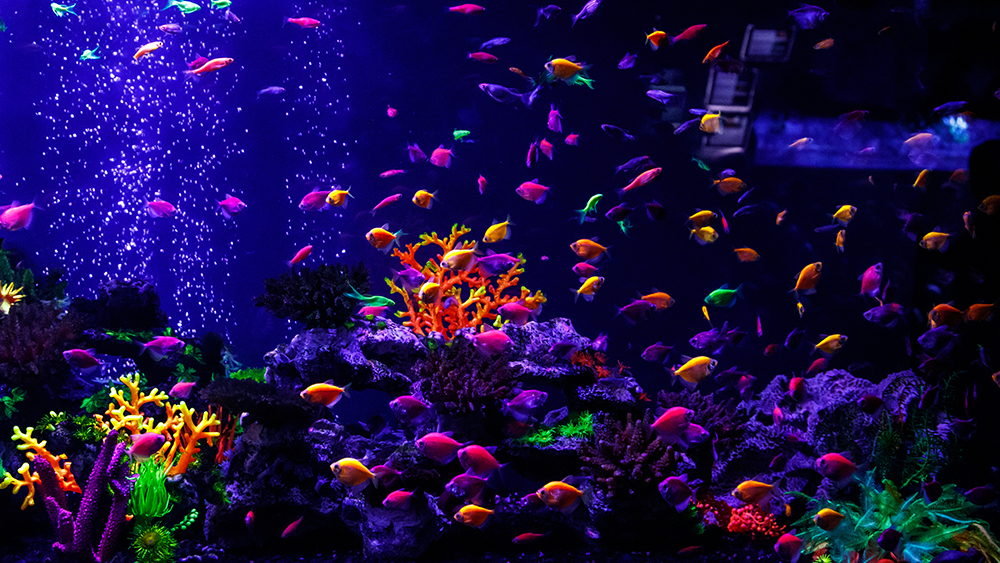Biofluorescence is a phenomenon in which creatures—plant or animal—absorb light at a certain wavelength and release or emit it at a different wavelength. The light from the animal becomes a different color from the light that was absorbed.
In 2020, ICR’s Dr. Jeff Tomkins discussed biofluorescence in the platypus, of all animals.
Biofluorescence is a glow-in-the-dark phenomenon in which short wavelengths of light are absorbed and longer wavelengths are re-emitted based on the specific bio-physical properties of hair, skin, scales, or feathers. Biofluorescence has been documented in a wide range of fish, reptiles, amphibians, and birds. Among mammals, biofluorescence of the fur when exposed to ultraviolet light has been previously demonstrated in several nocturnal taxa including marsupial opossums and placental flying squirrels. In this [2020] research paper from Mammalia, scientists have documented the fluorescence of the fur coat of the platypus (Ornithorhynchus anatinus) under ultraviolet light. That makes this the first report of biofluorescence in a monotreme mammal.1
SciNews recently published an article regarding this amazing ability in fishes.
Biofluorescence, the absorption of high-energy light and its reemission at lower energy wavelengths, is widespread across vertebrate and invertebrate lineages, especially fishes. According to two studies led by the American Museum of Natural History, fish biofluorescence dates back at least 112 million years and, since then, has evolved independently more than 100 times, with the majority of that activity happening among fish that live on coral reefs.2
The title of the recent article by the American Museum of Natural History is, “Fish Biofluorescence Has Evolved More Than 100 Times in 112 Million Years, Researchers Reveal.” Non-evolutionists would be more than satisfied to read how just one of those more than 100 examples evolved from scratch. Just one.
In the abstract of the referenced study by Carr et al. in Nature, the authors state,
In this study, we present a comprehensive account of all known biofluorescent teleosts [fishes] and estimate the timing and frequency of the evolution of biofluorescence across this diverse group. We show that biofluorescence evolved numerous times in marine teleosts and is estimated to date back ~112 mya in Anguilliformes (true eels).3
Do they “show” this? No. Additionally, to say “that biofluorescence evolved numerous times in marine teleosts” is not an explanation of biofluorescent origin, nor is saying that this complex biochemical process “has evolved independently more than 100 times.” Instead, we creationists say God created biofluorescence in a number of marine teleosts and in Anguilliformes (true eels) thousands of years ago.
But by rejecting God and His creation, evolutionists like Emily Carr of the American Museum of Natural History can only state that
to really get to the root of why and how these species use this unique adaptation — whether for camouflage, predation, or reproduction — we need to understand the underlying evolutionary story as well as the scope of biofluorescence as it currently exists.2
But there is no “underlying evolutionary story”2 to understand.
It is one thing for scientists to study the mechanism of biofluorescence and to elucidate the structure of proteins involved. For example, zoologists determined the structure of the green fluorescent protein (GFP) structure isolated from the jellyfish Aequorea victoria. It was found to be encoded by a single gene. But it is altogether different to claim in a science paper’s title the “Evolution of Biofluorescence in Marine Fishes”3 when this development has not been described.
Most evolutionists rely on the unscientific idea of convergent evolution4 in an attempt to explain, in this case, fluorescence. For example, “multiple red/green color diversification events in the [green fluorescent protein] superfamily may reflect convergent evolution of the more complex three-step pathway [emphasis added].”5 But Lee Spetner said,
Convergent evolution is…an invention. It was invented solely to avoid addressing the failure of the phylogenetic tree to support Common Descent. There is no theoretical support for convergence, and whatever evidence has been given for it is the product of a circular argument.6
Ugalde et al. also said that the “red color appears to have evolved gradually by small incremental transitions [emphasis added].”5 But what exactly were these small transitions? What was the biomolecule that began this conversion to the red color? Once again, evolution is claimed without being described or demonstrated.
Similarly, toward the end of the SciNews article, the reader is still left wondering about the origin of biofluorescence in fishes. The article ended with, “As these studies show, biofluorescence is both pervasive and incredibly phenotypically variable among marine fishes.”2 Who would doubt it? But what is the origin of biofluorescence? How did such a remarkable ability evolve via chance and time?
With no explanation on the origin of biofluorescence, we are forced to conclude that scientists simply do not have one. The conclusions based on the process of evolutionary development of biofluorescence are therefore suspect. When we turn our eyes to Scripture, however, we find a consistent and truthful answer: God made them all.
So is this great and wide sea, wherein are things creeping innumerable, both small and great beasts. (Psalms 104:25)
References
- Tomkins, J. Glow-in-the-Dark Platypuses Illuminate the Creator. Creation Science Update. Posted on ICR.org November 16, 2020, accessed July 16, 2025.
- Two New Studies Shed Light on Ancient Origins of Biofluorescence in Fishes. SciNews. Posted on sci.news June 17, 2025, accessed July 16, 2025.
- Carr, E. et al. Repeated and Widespread Evolution of Biofluorescence in Marine Fishes. Nature Communications. Posted on nature.com May 24, 2025, accessed July 16, 2025.
- Guliuzza, R. 2017. Major Evolutionary Blunders: Convergent Evolution Is a Seductive Intellectual Swindle. Acts & Facts. 46 (3): 17–19. 13.
- Ugalde, J. et al. 2004. Evolution of Coral Pigments Recreated. Science. 305 (5689): 1433.
- Spetner, L. M. 2014. The Evolution Revolution: Why Thinking People Are Rethinking the Theory of Evolution. New York: Judaica Press, Kindle Locations 1229–1231.
* Dr. Sherwin is a science news writer at the Institute for Creation Research. He earned an M.A. in invertebrate zoology from the University of Northern Colorado and received an honorary doctorate of science from Pensacola Christian College.


















